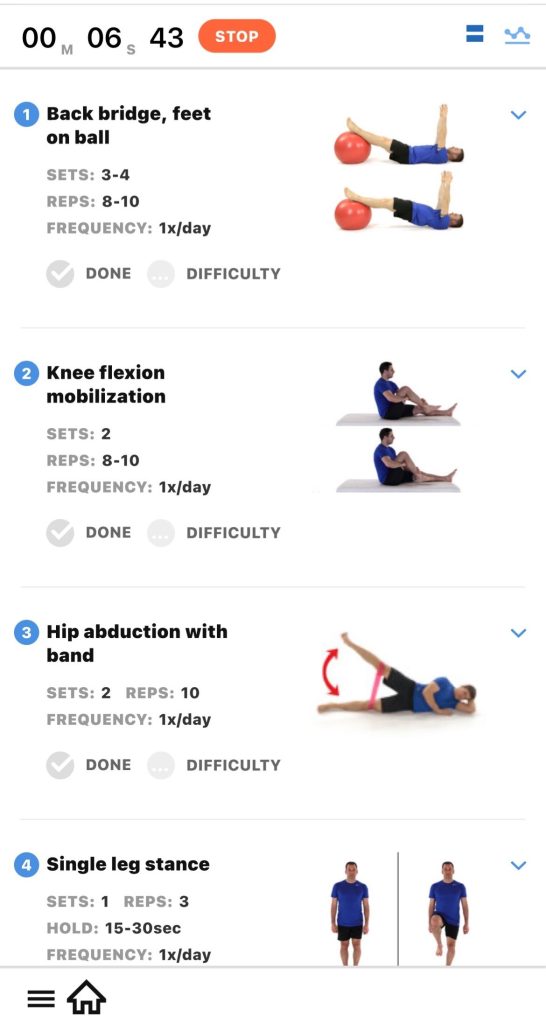I love skiing. It’s my favourite activity hands-down. It makes me feel powerful and joyous, is a dynamite form of exercise and offers social connections that have lasted my lifetime.
Which is why, when I broke my tibial plateau on my first day skiing last winter, I was really bummed out. After the “incident” I found myself hurtling down the mountain, shaking uncontrollably from shock, in the ski patrol’s dreaded rescue wagon, wondering what the next few months would bring.

It wasn’t going to be skiing, that’s for sure, but I was determined to heal as quickly and thoroughly as possible so I could get back up on skis next season. My mental and physical health depend on it.
After being x-rayed and diagnosed in the local emergency department, my visit with the orthopedic surgeon was swift as fortunately, I did not require surgery.
What I did require however was six weeks of immobility and six months or so of ongoing physiotherapy . Little did I know how important physiotherapy would become to my ability to return to the slopes.
What Do Physiotherapists Do?
Physios are the lynchpin of recovery, whether it be from an injury, or potentially even an illness. As healthcare providers, they evaluate and treat people of all ages for many purposes.
Whether it’s pain management and/or rehabilitation from an acute injury such as mine, or management of chronic conditions such as diabetes or heart disease, physiotherapy can help.
Physiotherapists work in many healthcare settings such as private clinics, family health organizations, hospitals, retirement residences and child development centres.
If you’ve been admitted to the hospital for surgery, for example heart or knee replacement surgery, a physiotherapist was likely a member of your circle of care.
Treatments Physios Offer
Physiotherapists work in many ways, with the goal of putting you in the driver’s seat of your own recovery. Since I was not hospitalized, engaging with a physio was 100 per cent my own choice, but it’ll be recommended by your doctor for recovering from severe injuries.
What I didn’t realize at the time was that my physiotherapist was practically the only healthcare provider I was going to work with on my healing journey. I saw my orthopedic surgeon twice during the process, and for perhaps 10 minutes each time. Clearly, my case wasn’t interesting.
My physio however was crucial to my healing process. She helped start me on my exercise regime even when I was totally immobilized. Her weekly in-office treatments were so welcome (difficult as it was to get there in the beginning), as was her constantly evolving movement and strength program that I dutifully followed to a “T”.
Physios have some powerful treatments at their fingertips to help treat both acute injury and some illnesses. The impact of following a rehabilitation program with a physiotherapist can go well beyond simply wanting to do your favourite sport again.
For example, cardiac rehabilitation is crucial to healing from heart surgery. Research has shown that patients who do not complete cardiac rehab have an increased risk of cardiovascular events over the long-term.
Patients who undergo musculo-skeletal surgery such as total knee replacement or hip replacement also benefit greatly from post-surgery physiotherapy. Only half of patients receiving this kind of surgery are active enough post-surgery, which studies show lead to increased levels of pain, decreased functionality and quality of life.
Depending on your needs, a physio may offer:

- Personalized exercise programs designed to achieve your goals. Many physios offer exercise programs via an app so the patient can be anywhere to do their program.
- Therapeutic massage.
- Joint mobilization and manipulation.
- Hot and cold packs and modalities such as TENS to relieve pain, reduce swelling, speed up the healing process, improve movement and function.
- Respiratory physiotherapy – airway clearance methods to assist people with breathing difficulties.
- Some can provide skin and wound care.
- Pelvic floor re-education.
- Functional activity and tolerance testing and training.
- Occupational worker re-training and return to work planning.
- Prescription, fabrication and usage of assistive, adaptive, supportive and protective devices and equipment.
Cost of Physiotherapy
Medicare coverage in Canada for physiotherapy varies widely across provinces and territories.
In general, publicly funded physiotherapy is only available to specific groups, including:
- Hospitalized patients (inpatients)
- Outpatients that meet specific criteria such as recent surgery or injury for which they were hospitalized
- Adults 65+
- Children and young adults under the age of 19
- Recipients of social assistance
Because coverage varies so widely across the country, it’s wise to check with your provincial or territorial health plan for specifics.
For those paying out of pocket, the cost will depend on the clinic and the services offered. Expect to pay anywhere from $70 or more per hour. Most private insurance plans will cover physiotherapy. Check with your provider for details.
Following the guidance of your physiotherapist and actually doing the exercises they prescribe can mean the difference between getting back to your active state of being – or not.

Risks of Ignoring Physiotherapy
Ignoring physical therapy may lead to significant risks and complications. Here are some of the key risks you should be aware of as you make your decision whether to invest in physiotherapy.
1. Delayed Healing and Prolonged Recovery
Physical therapy promotes blood flow and helps in the delivery of nutrients to the injured area, facilitating faster healing. Skipping therapy can slow down the healing process and as a result, pain may persist longer than necessary.
2. Loss of Mobility and Function
Physical therapy helps maintain and restore joint and muscle flexibility. Ignoring it can lead to stiffness and reduced mobility. Without guided exercises, muscles around the injured area can weaken, leading to a loss of function and strength.
3. Development of Compensatory Movements
Without rehabilitation, individuals may develop compensatory movements to avoid pain, which can lead to improper body mechanics and strain on other body parts. These movements can put additional stress on other muscles and joints, increasing the risk of further injuries.
4. Chronic Pain and Conditions
Neglecting physical therapy can result in chronic pain conditions due to unresolved issues like muscle imbalances or joint dysfunctions. Conditions such as arthritis or tendinitis may worsen.
5. Loss of Independence
Ongoing pain and mobility issues can affect the ability to perform daily activities, leading to a loss of independence and reduced quality of life.
6. Psychological Impact
Chronic pain and prolonged recovery can lead to depression, anxiety, and a sense of hopelessness, which may also decrease motivation to engage in physical activities or adhere to future treatment plans.
7. Potential for Re-injury
Weakness and instability from an incomplete recovery can make the injured area more susceptible to re-injury.
8. Permanent Disabilities
Prolonged neglect of physical therapy can lead to irreversible damage and permanent disabilities and in some cases may result in the need for more invasive treatments, such as surgery.
9. Cost Implications
Chronic conditions and complications from inadequate rehabilitation can lead to higher medical expenses over time. Extended recovery periods can affect an individual’s ability to work, resulting in financial loss.
10. Decreased Cardiovascular Health
Avoiding physical therapy may lead to decreased overall physical activity, negatively impacting cardiovascular health. Sedentary behavior increases the risk of secondary health issues such as obesity, diabetes, and heart disease.
While slowly healing from my broken leg I reminded myself daily that there was a lot I could do to take control of my healing process and how important the physiotherapy process was to my overall health.
A good physio will help you open the door to recovery, but the key to success lies with you and the hard work you put in.
As a result of my healing grind, the woman whizzing past you smiling from ear to ear on the ski hill next year? That’ll be me.
~ Read more from The Health Insider ~
- Health Canada Authorizes First 8-Week Treatment for Acute Hepatitis CHealth Canada’s approval of MAVIRET for acute HCV allows doctors to treat adults and children immediately, a key step toward the 2030 elimination goal.
- The 7-Day Reset: A Social Media Break Can Transform Your Mental HealthDiscover why science says you only need one week off social media to lower anxiety and sleep better. A practical guide for the modern Canadian.
- The Science of Sweat: How Saunas Boost Heart & Brain HealthExplore the life-extending benefits of sauna use. Compare traditional and infrared costs, health benefits and safety in our expert guide.
- There’s a Reason Your Voice May Not Be As Clear as it Can BeFrom dry winters to loud parties, your voice takes a beating. Learn how to protect your “vocal instrument” with these expert tips and SAC guidelines.
- Leftovers Safety: Store & Reheat Like a ProLearn how to store and reheat holiday leftovers safely. From the “Two-Hour Rule” to freezing tips, keep your Canadian kitchen healthy this season.
- Guilt-Free Indulgence for the Holidays. This is How it’s Done.Enjoy every plate this season! Prep your gut with our low-effort tips: boost hydration, sip digestive tea, and avoid the post-feast crash.
The information provided on TheHealthInsider.ca is for educational purposes only and does not substitute for professional medical advice. TheHealthInsider.ca advises consulting a medical professional or healthcare provider when seeking medical advice, diagnoses, or treatment. To read about our editorial review process click here.
















